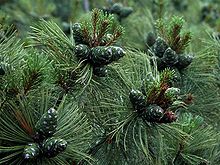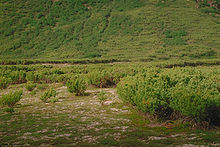| Pinus pumila | |
|---|---|

| |
| Conservation status | |
 Least Concern (IUCN 3.1) | |
| Scientific classification | |
| Kingdom: | Plantae |
| Clade: | Tracheophytes |
| Clade: | Gymnospermae |
| Division: | Pinophyta |
| Class: | Pinopsida |
| Order: | Pinales |
| Family: | Pinaceae |
| Genus: | Pinus |
| Subgenus: | P. subg. Strobus |
| Section: | P. sect. Quinquefoliae |
| Subsection: | P. subsect. Strobus |
| Species: | P. pumila |
| Binomial name | |
| Pinus pumila (Pall.) Regel | |
| Synonyms | |
| |

Pinus pumila, commonly known as the Siberian dwarf pine, dwarf Siberian pine, dwarf stone pine, Japanese stone pine, or creeping pine, is a tree in the family Pinaceae native to northeastern Asia and the Japanese isles. It shares the common name creeping pine with several other plants.
Description
| This section does not cite any sources. Please help improve this section by adding citations to reliable sources. Unsourced material may be challenged and removed. (December 2017) (Learn how and when to remove this message) |
The Siberian dwarf pine is a coniferous evergreen shrub ranging from 1–3 metres (3–10 feet) in height, exceptionally up to 5 m (16 ft), but may have individual branches that extend further along the ground in length. In the mountains of northern Japan, it sometimes hybridizes with the related Japanese white pine (Pinus parviflora); these hybrids (Pinus × hakkodensis) are larger than P. pumila, reaching 8–10 m (26–33 ft) tall on occasion.

The leaves are needle-like, formed in bundles of five and are 4–6 centimeters long. The cones are 2.5–4.5cm long, with large nut-like seeds (pine nuts).
Distribution
The range covers the Far East, Eastern Siberia, north-east of Mongolia, north-east of China, northern Japan and Korea. Siberian dwarf pine can be found along mountain chains, above the tree line, where it forms dense, uninterrupted thickets; it also grows on the headlands above the Okhotsk and Bering Seas, Tatarsk and Pacific coast (the Kurils).
P. pumila grows very slowly. It can live up to 300 and, in some instances, 1,000 years. In the colder conditions of Siberia, there are specimens which are 250 years old and older.
Ecology
The seeds are harvested and dispersed by the spotted nutcracker (Nucifraga caryocatactes).
Cultivation
This plant is grown as an ornamental shrub in parks and gardens. The cultivar P. pumila 'Glauca' has gained the Royal Horticultural Society's Award of Garden Merit.
See also
References
- ^ Farjon, A. (2013). "Pinus pumila". IUCN Red List of Threatened Species. 2013: e.T42405A2977712. doi:10.2305/IUCN.UK.2013-1.RLTS.T42405A2977712.en. Retrieved 19 November 2021.
- ^ "Pinus pumila". World Checklist of Selected Plant Families (WCSP). Royal Botanic Gardens, Kew. Retrieved 29 December 2017.
- ^ "Pinus pumila". Germplasm Resources Information Network. Agricultural Research Service, United States Department of Agriculture. Retrieved 18 December 2017.
- Fukui, K.; Sone, T.; Yamagata, K.; Otsuki, Y.; Sawada, Y.; Vetrova, V.; Vyatkina, M. (2008). "Relationships between permafrost distribution and surface organic layers near Esso, central Kamchatka, Russian Far East". Permafrost and Periglacial Processes. 19 (1): 85–92. doi:10.1002/ppp.606. S2CID 130100766.
- Piragis, Alexander (11 August 2024). "Pinus pupils (Dwarf Siberian Pine)". Gardenia. Retrieved 11 August 2024.
- Koropachinsky, Vstovskaya, 2002
- "RHS Plant Selector - Pinus pumila 'Glauca'". Retrieved 6 February 2021.
External links
- Conifers Around the World: Pinus pumila - Hai-Matsu.
- [REDACTED] Media related to Pinus pumila at Wikimedia Commons
- [REDACTED] Data related to Pinus pumila at Wikispecies
| Taxon identifiers | |
|---|---|
| Pinus pumila |
|
| Pinus cembra var. pumila | |


